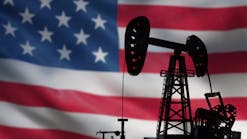US BLM finalizes rule to cut venting, flaring, leaks on onshore public and Tribal lands
The Department of the Interior’s Bureau of Land Management (BLM) on Mar. 27 issued a final rule to cut venting, flaring, and leaks on onshore public and Tribal lands by modernizing 40-year-old regulations.
The final Waste Prevention Rule could generate more than $50 million in additional natural gas royalty payments each year to federal taxpayers and Tribal owners by conserving billions of cubic feet of natural gas that would have otherwise vented, flared, or leaked from oil and gas operations, BLM explained.
Federal and Indian onshore lessees reported total venting and flaring averaged 44.2 bcf/year between 2010 and 2020, BLM said.
“This rule represents a common sense, fair, and equitable solution to preventing waste that provides a level playing field for all of our energy-producing communities,” said BLM Director Tracy Stone-Manning.
The final rule responds to a series of US Government Accountability Office reports that highlight revenue lost due to BLM’s outdated regulations.
'Separate and distinct'
Several states, including Colorado, New Mexico, Pennsylvania, and Wyoming, as well as the US Environmental Protection Agency (EPA), have already taken steps to limit venting, flaring, and leaks from oil and gas operations to prevent waste and improve air quality (OGJ Online, Dec. 4, 2023).
BLM noted that the final rule is “separate and distinct” from the EPA rule but still ensures that operators can comply with applicable state, Tribal, or federal rules while meeting new requirements.
“BLM and EPA worked closely to ensure the two rules avoid duplicative or contradictory requirements for industry, though the rules serve different purposes,” BLM said. BLM issued its rule under the Mineral Leasing Act that obligates Interior and its agencies “to use all reasonable precautions to prevent waste of oil and gas.”
The BLM rule requires operators of federal and Indian oil and gas leases to take “reasonable steps to avoid natural gas waste from the very beginning of operations,” carry out leak detection and repair across ongoing operations and cut down on gas venting and flaring using current technologies and practices.
Consistent with the Inflation Reduction Act, the rule also sets new limits on “royalty-free” flaring, so that public and Tribal mineral owners are “properly compensated through royalty payments for avoidable losses of natural gas,” BLM said in a fact sheet accompanying the rule.
BLM said it received thousands of comments before finalizing the rule and made several changes based on input from the public, companies, and associations. BLM removed from its initial proposal requirements for certain equipment because they did not provide sufficient additional waste reduction.
The final Waste Prevention Rule will go into effect 60 days after publication in the Federal Register, expected within days. New requirements under the rule will be phased in to allow time for operators to appropriately adjust, BLM said. For example, some flaring limits will go into effect roughly 60 days after the effective date of the rule, while some flare measurements will be required 6, 12, or 18 months after the effective date. Operators will have 18 months to submit leak detection and repair plans to BLM state offices, BLM added.
The American Petroleum Institute (API) called the rule “regulatory overreach” that could hinder emissions progress and slow energy production.
“API supports a smart regulatory framework for reducing methane emissions, but overlapping regulations and lack of coordination between policymakers could hinder progress, create unnecessary barriers to development on federal lands and result in regulatory incoherence,” API’s vice-president of upstream policy Holly Hopkins said in a statement.
API is reviewing the rule and will “consider all options to prevent regulatory overreach,” she said.
Cathy Landry | Washington Correspondent
Cathy Landry has worked over 20 years as a journalist, including 17 years as an energy reporter with Platts News Service (now S&P Global) in Washington and London.
She has served as a wire-service reporter, general news and sports reporter for local newspapers and a feature writer for association and company publications.
Cathy has deep public policy experience, having worked 15 years in Washington energy circles.
She earned a master’s degree in government from The Johns Hopkins University and studied newspaper journalism and psychology at Syracuse University.


